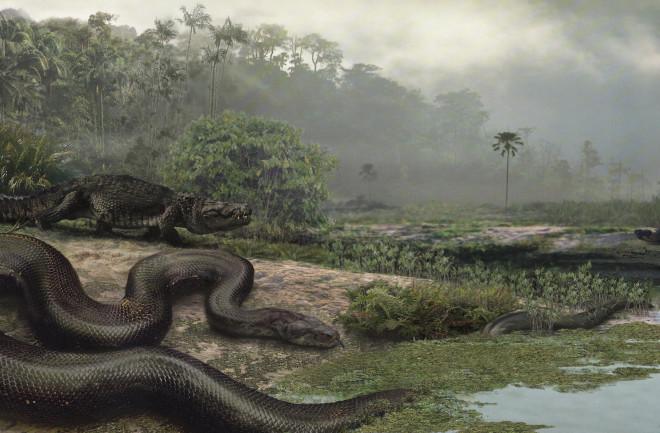Titanoboa has long been heralded as the largest of large snakes. Slithering through the Paleocene at an estimated 45 to 50 feet, this ancient snake appears in almost every list of large snakes, and almost always at the top.
But now another ancient snake is sliding up those lists.
Named Vasuki indicus, and identified in a new paper published in Scientific Reports, this new snake slunk through the Eocene at an estimated 36 to 50 feet. If accurate, these estimates establish this new snake as an equal to Titanoboa, and as one of the largest —and longest — snakes that ever lived.
Read More: Meet Titanoboa: The Biggest Snake In the World
Larger Than Large Snakes
Though the 45-to-50-foot Titanoboa has dominated the world of snakes since its initial discovery and description around 15 years ago, it wasn’t the only lineage of large snake that slithered through the ancient terrain.
In April 2024, a pair of paleontologists from the Indian Institute of Technology Roorkee described an ancient snake specimen with 27 fossilized vertebrae. Measuring around 1.5 inches and 2.5 inches in length and around 2.5 inches and 4.4 inches in width, these fossilized vertebrae indicate that the snake was an adult when it died. With a broad body, the snake measured somewhere between about 36 feet and 50 feet long.
Though the paleontologists stress that these estimates are only estimates, their study suggests that the snake was similar in size to Titanoboa, hinting that the famously long snake wasn’t alone in its length.
Enriching our understandings of our planet’s large, long-lost inhabitants, the specimen — deemed V. indicus for the serpent deity that adorns Shiva’s throat in the tales of Hinduism and for the location of its discovery — embodies a late, extra-large lineage of Indian madtsoiidae snake. Though now extinct, its existence stresses that the longest snakes were spread throughout the ancient world, and throughout the ancient ages, as well.
Read More: These 3 Prehistoric Snakes Are the Stuff of Nightmares
The Snakes Didn't Live Side-by-Side
While the Titanoboa-type specimen was found in the Cerrejón Mine in Colombia, from approximately 58 million years ago, the Vasuki-type specimen was found in the Panandhro Mine in India, from approximately 47 million years ago. Thus, while one of these snakes terrorized the prey of Paleocene South America, the other tormented the Eocene inhabitants of South Asia.
Though the two snakes didn’t live side by side, they did share similar lifestyles. According to the paleontologists behind both finds, the size of the snakes probably slowed their movement and pushed their predation strategies toward the technique of ambush. Similar to the anacondas of today, Titanoboa snakes likely lurked in and around the shallow waters of antiquity, where they sat and waited to seize their suppers, while Vasuki might’ve applied a similar sit-and-strike approach.
While Titanoboa belonged to the boidae family, which includes all anacondas and boas today, Vasuki belonged to the madtsoiidae family, which lived in Asia, Europe, and Africa for approximately 100 million years. According to the paleontologists behind the Vasuki find, the V. indicus lineage likely originated in India before spreading to Europe and Africa.
Read More: 10 of the World’s Deadliest Snakes
Article Sources:
Our writers at Discovermagazine.com use peer-reviewed studies and high-quality sources for our articles, and our editors review them for accuracy and trustworthiness. Review the sources used below for this article:
Scientific Reports. Largest Known Madtsoiid Snake From Warm Eocene Period of India Suggests Intercontinental Gondwana Dispersal
Florida Museum. Titanoboa
Britannica. Titanoboa
Britannica. Indian Cobra
Nature. Giant Boid Snake From the Palaeocene Neotropics Reveals Hotter Past Equatorial Temperatures
Eurekalert. Palaeontology: Discovery of New Ancient Giant Snake in India
Sam Walters is a journalist covering archaeology, paleontology, ecology and evolution for Discover, along with an assortment of other topics. Before joining the Discover team as an assistant editor in 2022, Sam studied journalism at Northwestern University in Evanston, Illinois.

